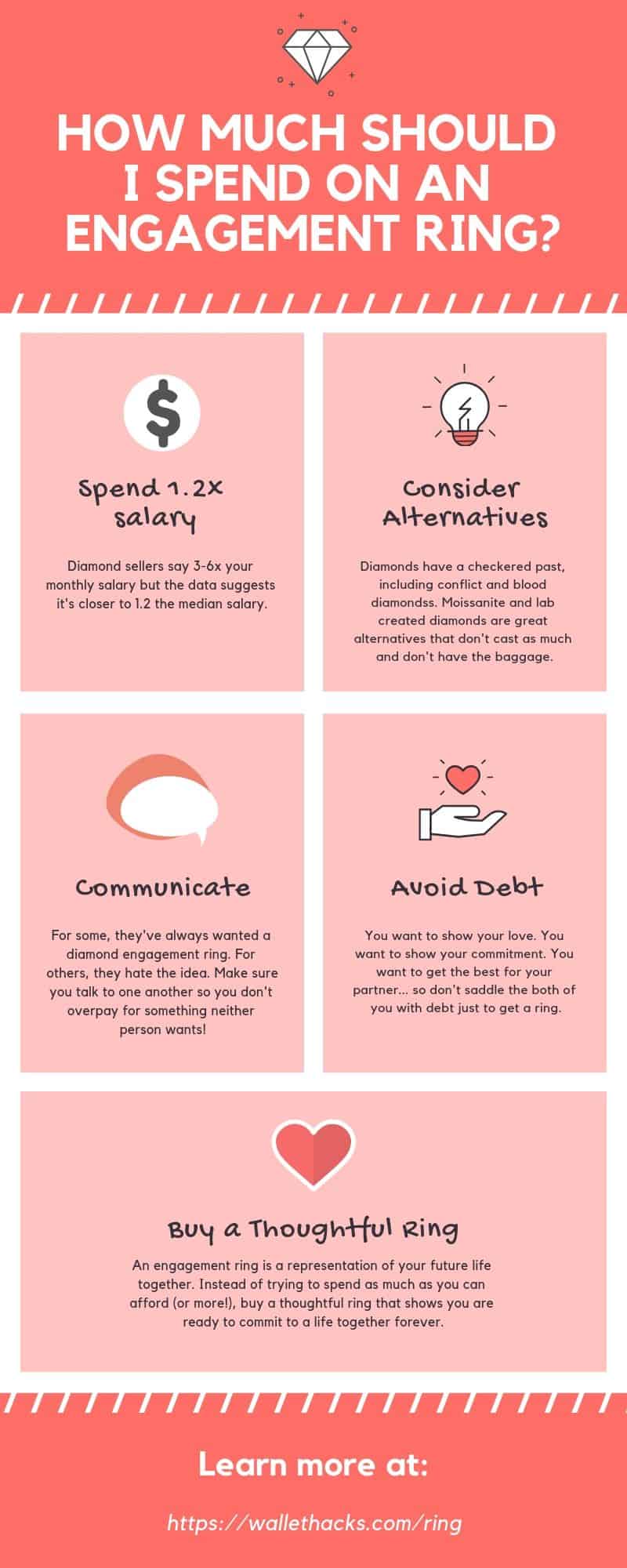
As much as possible!
Just kidding.
It’s 2 months of your salary. Or is it three? Six?
Turns out we can thank a major diamond company (hint: rhymes with “The Beers”) and their marketing department. They came up with those benchmarks.
We can thank marketing for “diamonds being forever.” We can even thank them for why diamond engagement rings are even a thing in the first place.
And it’s all recent too, like mid-20th century.
This isn’t hundreds of years of history. We know this because they probably weren’t mass mining diamonds during the Renaissance. 🙂
(for a full history lesson, this Pricenomics post on diamonds is a must read)
In the end, it has now become custom and it doesn’t matter who started it.
So how much should you spend on an engagement ring? How can you save money on buying the engagement ring? And what else should you know? Read on.
Table of Contents
- How much should I spend on an engagement ring?
- Buy a thoughtful ring together, not just a pricey one
- What are affordable alternatives to diamonds?
- What should I know about conflict diamonds?
- How much should I borrow to buy an engagement ring?
- How can you save money when buying an engagement ring?
- Conclusion
How much should I spend on an engagement ring?
This is the $64,000 question… and if the diamond industry had their way, the answer would be $64,000.
If you’ve heard that you should be spending 2 months of your salary on a ring, it’s because of the De Beers diamond cartel. De Beers controls a huge percentage of the diamond trade in during the Great Depression, they took a huge hit to business.
To counter this, they tied diamonds to engagements (it wasn’t before then) and had a huge advertising push in the 1930s to convince people they should spend a month’s salary on this piece of jewelry. By the 1980s, they’d pushed that amount to two months. If you believe the number is three, they tried pushing that too.
(don’t forget that the engagement ring’s history is a little uglier – it may tie back to a Roman custom where wives wore rings attached to small keys, to show ownership by the husband!)
Given the marketing, what’s the answer to the age-old question of “how much should I spend on an engagement ring?”
The answer is – that depends.
The idea behind the original thought – 2 months – was that if you wanted to show your love and commitment, you wanted to show you also had the means. 2 months salary seemed like a fair amount to someone looking to sell a diamond, but is it fair? The median salary in America based on 2015 Census data is $56,516 – or $4709 a month.
Two months salary is $9,419.
The Knot’s 2017 Real Weddings Study, of 13000 couples surveyed online, found the average engagement ring cost $5,764.
That’s “just” 1.22 months salary.
If you want a rule, spend about one month of salary and you will find yourself within range of the median.
But does that make sense?
Buy a thoughtful ring together, not just a pricey one
A successful engagement is rarely a shock. The proposal may be a surprise but the engagement is usually seen from a mile away.
If you’re expected to pay 1-2 months of salary for a ring, it makes sense to talk about the ring.
Much like those holiday commercials of ridiculous people gifting each other cars with massive bows, you shouldn’t be buying an engagement ring in a vacuum. You can talk with your partner about it before to get an idea of what she likes and would want. Some women appreciate and want an expensive ring, others don’t.
Here’s a discussion my friend Stefanie O’Connell had about engagement rings and her choice to give back her engagement ring:
The takeaway from the video isn’t that there is a right answer for every situation but that conversations are important. You want to meet the expectations of your partner and give them what they want, not what you think they want or what you want. Communication is key!
What are affordable alternatives to diamonds?
Diamond engagement rings are by far the most expensive type of engagement ring. Diamonds themselves are very expensive (you can save a bit by going with a synthetic diamond).
There are beautiful stones that don’t have the cost, and baggage, that diamonds carry. If you get creative, there are plenty of alternatives to a diamond engagement ring.
The most well-known diamond alternative is cubic zirconia. Scientifically called Zirconium dioxide (it’s the cubic crystalline form of ZrO2), it is a synthesized stone that is visually flawless and colorless. It’s manufactured so you can actually make it any color whatsoever but it’s remarkably cheap. It’s incredibly affordable and if you’re familiar with diamonds, the biggest visual “complaint” about it cubic zirconia that it’s too bright, too flawless, and perfect. If you put one next to a diamond, it looks “fake” because it’s too good.
You can buy a 1 ct CZ “diamond” for ~$4.
Another diamond alternative is moissanite, named after the French scientist who discovered it, Henri Moissan. He discovered microscopic particles of moissanite in a meteor crater and identified them as silicon carbide.
Natural moissanite is rare. Lab-created moissanite is not.
You can create moissanite in a laboratory easily. They are visually different than a diamond but they make for a fine alternative. They are more brilliant, owing to their faceting pattern, and more on the yellow/gray side compared to diamonds.
You can buy a 1 ct moissanite gem for ~$400.
One final alternative is a lab-created diamond, which will be cheaper than one mined from the ground and carry less of the social cost too.
You can buy a 1 ct lab created diamond for ~1,500.
You can buy a 1 ct diamond for anywhere from $2,400 to $18,000.
(these are all ballpark prices, the 3Cs of the diamond can make its value change significantly)
Cubic zirconia and moissanite are the two diamond alternatives that look like diamonds, but plenty of folks go a completely different direction for the gem in an engagement ring. The most popular include going with the birthstones of your future bride, all the birthstones (except perhaps April, which is diamond), or find a completely different stone that captures her personality.
Here are the classic birthstones:
- January – Garnet
- February – Amethyst
- March – Aquamarine
- April – Diamond
- May – Emerald
- June – Pearl
- July – Ruby
- August – Peridot
- September – Sapphire
- October – Tourmaline
- November – Citrine
- December – Tanzanite
What should I know about conflict diamonds?
As is the case with anything of value, diamonds have a checkered past. Conflict diamonds, also known as blood diamonds, are part of that history. It refers to diamonds mined in armed conflict zones.
When dealers sell those diamonds, the money goes to finance more wars and conflict. It’s an ugly cycle. Many of those diamonds come from Africa.
Once these stories came to mainstream attention, it’s easy to understand why a blushing bride would like to avoid one of these diamonds on their finger.
In 2000, the Kimberley Process Certification Scheme (KPCS) was established to prevent conflict diamonds from entering the mainstream rough diamond market. It’s debatable how effective it is but it was a good first step.
To avoid conflict diamonds, make sure your jeweler knows where the diamond comes from. If it’s Kimberley Process certified or it’s outside of Africa, you’re usually safe with respect to conflicts. If it’s inside Africa, check to see if that area has an active conflict (but even this is imperfect). Diamonds mined in Canada are usually safe and there’s a CanadaMark Certification you can look for.
You can never be too sure (unless you go with a diamond alternative) but those steps can help.
How much should I borrow to buy an engagement ring?
If you want to be happy for the rest of your life, the answer is $0.
Don’t go into debt for jewelry. Jewelry is never worth as much as you paid for it. Try selling jewelry and you’ll be in for a little surprise.
Next, I’m not anti-debt. I have a mortgage, I had student loans, and I recognize the value of leverage. Given the choice, you should only go into debt for assets that appreciate.
But sometimes you have no choice. You may need a loan to buy a car that will take you to your job. But with an engagement ring you have a choice. The ring is important but it’s not the same as a car.
We have data that supports how debt kills marriages. If the engagement is about marriage and marriage is about a partnership you will take into your old age, you must avoid unnecessary debt.
In 2009, The Marriage Project by Jeffery Dew, a faculty fellow at the National Marriage Project and an assistant professor of Family, Consumer, and Human Development at Utah State University, conducted research on the role of debt in marriage satisfaction. His research indicates something we can all intuitively guess – consumer debt erodes the quality of married life.
If you want to increase marriage satisfaction, it’s not about the size of the ring but the size of your consumer debt. You won’t be able to avoid it in some instances, such as a mortgage or a car, but why enter it lightly?
How can you save money when buying an engagement ring?
Once you’ve decided what you want to buy, where you buy it matters too.
The worst place to buy it is in a physical store. It’s the same reason why online banks have better interest rates than brick and mortar banks – the economics are different. The stores at the mall have overhead costs an online retailer won’t. The rent, the cost of employees, the security, the insurance, not to mention shipping and huge marketing budgets responsible for the ads you see everything during the holidays.
Online stores don’t have any of that stuff. Blue Nile and James Allen are two of the biggest online retailers.
Another reason is that many of the psychological tricks salespeople use will only work in person. When you buy an engagement ring online, there are no games or tricks. Just the diamond and the ring.
There are other tactics retailers can use but they’re less effective. They may use scarcity (this is the only one left!) but they won’t butter you up, try to be your friend, or offer up some fantastic financing deal you just can’t turn down while plying you with glasses of champagne.
When buying, keep in mind that diamonds are rated by one of two reputable major rating agencies – the Gemological Institute of America (GIA) and American Gem Society (AGS). They’re both good rating systems and sometimes it comes down to the preference of the retailer and the diamond.
American Gem Society (AGS) Rating System

The AGS rating system rates a diamond on three C’s (cut, clarity, color) with a 0-10 scale, with the highest rating being a zero.
For Cut (whole number increments):
- AGS Ideal: 0
- AGS Excellent: 1
- AGS Very Good: 2
- AGS Good: 3-4
- AGS Fair: 5-7
- AGS Poor: 8-10
For Color (half number increments):
- Colorless: 0.0 – 1.0
- Near Colorless: 1.5 – 3.0
- Faint: 3.5 – 4.5
- Very Light: 5.0 – 7.0
- Light: 7.5 – 10.0
- Fancy Yellow: Fancy Yellow
For Clarity (mostly whole number increments):
- Flawless/IF: 0
- Very Very Slightly Included: 1-2
- Very Slightly Included: 3-4
- Slightly Included: 5-7.5
- Included: 7.5-10
Gemological Institute of America (GIA) Rating System

The GIA rating system rates a diamond on three C’s (cut, clarity, color) but doesn’t use a simple 0-10 scale but has it’s own letter rating system.
For Cut, they simply call it Excellent, Very Good, Good, Fair, or Poor. No numbers.
For Color, they use the letters D – Z:
- Colorless: E – F
- Near Colorless: G – J
- Faint: K – M
- Very Light: N – R
- Light: S – Z
- Fancy Yellow: Fancy Yellow
For Clarity, it’s an acronym with subscript grades:
- Flawless/IF: Flawless/IF
- Very Very Slightly Included: VVS1, VVS2
- Very Slightly Included: VS1, VS2
- Slightly Included: SI1, SI2
- Included: I1, I2, I3
Conclusion
In the end, it’s about finding the right gem for the right person – not necessarily the most expensive gem. If you have the means and the desire, buy whatever you want and spend whatever you want. It is your money, your life, and you shouldn’t have to get permission to do things your way.
If you are looking for an engagement ring, give James Allen’s engagement rings a look. They are one of the largest retailers and every loose diamond is conflict-free. They have a popup that gives you $100 off your first purchase when you join their mailing list.
If you would have to go into debt or if it would otherwise stretch you, give it a little more thought and see how this large purchase fits into your overall plan.






Tex Ginsburg says
Excellent advice Jim. Deep in debt, or with a big hole in your bank account is no way to start off your married life. I would add, if your spouse to be is a stickler for real diamonds and the 2+ months salary – you may want to re-think the engagement as well as the ring. Her priorities with YOUR money now will give you a preview of your financial future.
Debt is an anchor that weighs around your neck… it can’t be good for a relationship. 🙂
Jennifer says
I agree wholeheartedly with all your brilliant advice!!! Even though I won’t be purchasing an engagement ring it was a very well thought out and refreshing article nonetheless. I would not want my future husband to go into debt, debt that soon would turn into our debt, over a piece of jewelry. It’s just my opinion, but I am more of a sentimental person and I would cherish whatever my love picked out special for me. That’s the idea, it’s supposed to be about love, not the carat size!! I am really enjoying your articles, thank you for the great advice and information!
Thanks Jennifer!
That’s why having the conversation is so important. It’s perfectly OK to want a ring with a big diamond. It’s perfectly OK to not want a ring with a big diamond or even a diamond. You should wear whatever it is YOU like. It’s not OK to get something your partners doesn’t want and even worse if you go into debt to get it!
Catherine says
GIA student here: Those are the “new” birthstones, not the traditional ones. Also, most of them are not suitable as a daily wear stone- certainly not Tanzanite (brittle). Sapphire comes in every color of the rainbow (even red- though that is called ruby) and is second in hardness to diamond. It is a good alternative engagement ring in color and price.
Also, antique diamond rings solve both the price and “conflict” issues as a larger stone can be purchased for less than a new one. If you don’t like the setting, having it re-set is no big deal and still less than a new ring in a baby blue box.
Mythina says
Hi Jim,
I enjoyed the article, particularly enjoyed the information about blood diamonds. (I had heard the term at one point, but no explanation. “Conflict diamond” was a new term to me.) Moissanite is gorgeous; thank you for putting that on my radar!
There is a typo I thought you might like to correct regarding the birthstones paragraph:
“The most popular include going with the birthstones of your future bride, all the birthstones (except perhaps May, which is diamond)…”
“May” should read “April” (as is indicated in the following itemization).
Thanks again for the article and for this site. It’s great to find such a trove of information!
Best,
– Mythina
Thanks for catching my error!